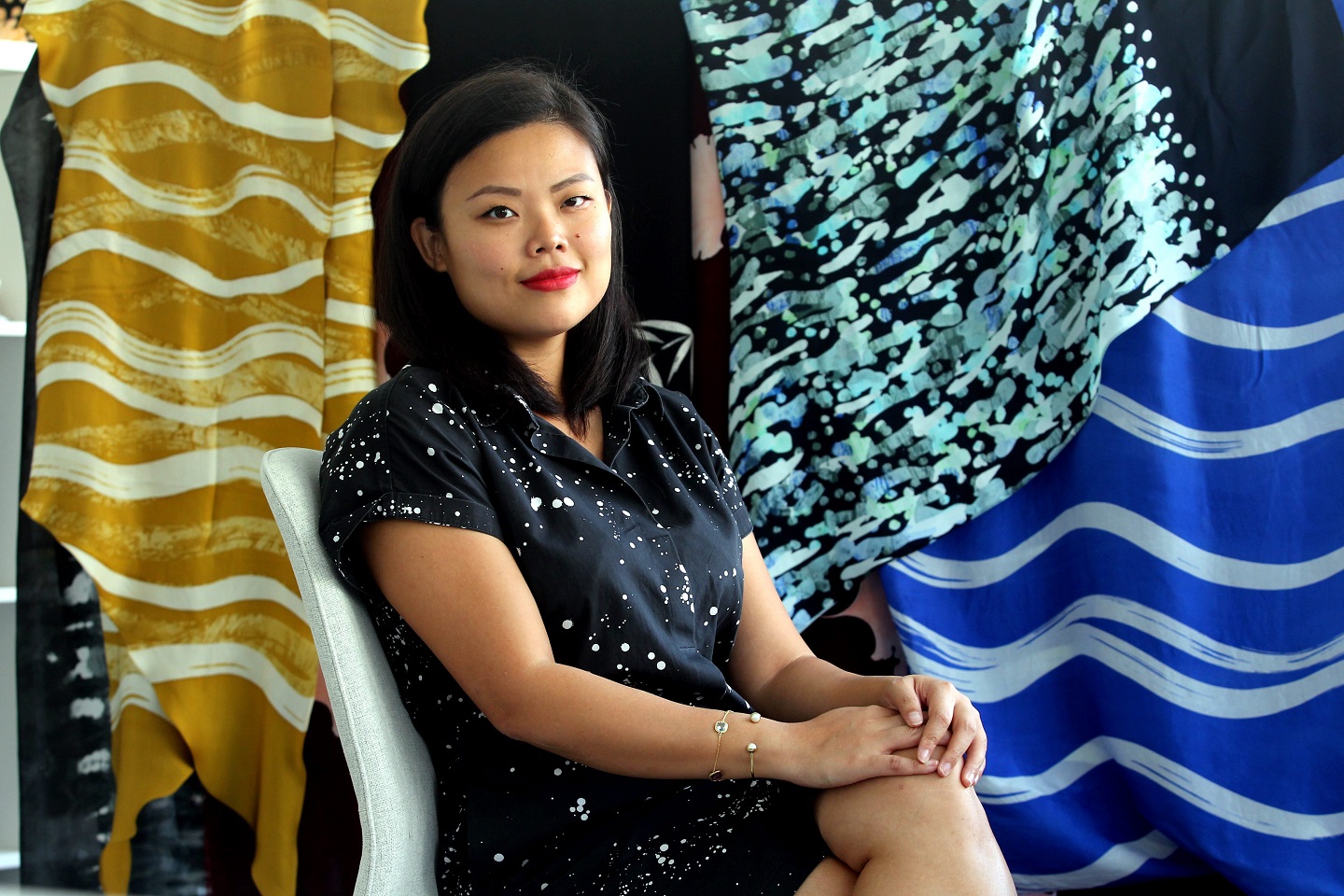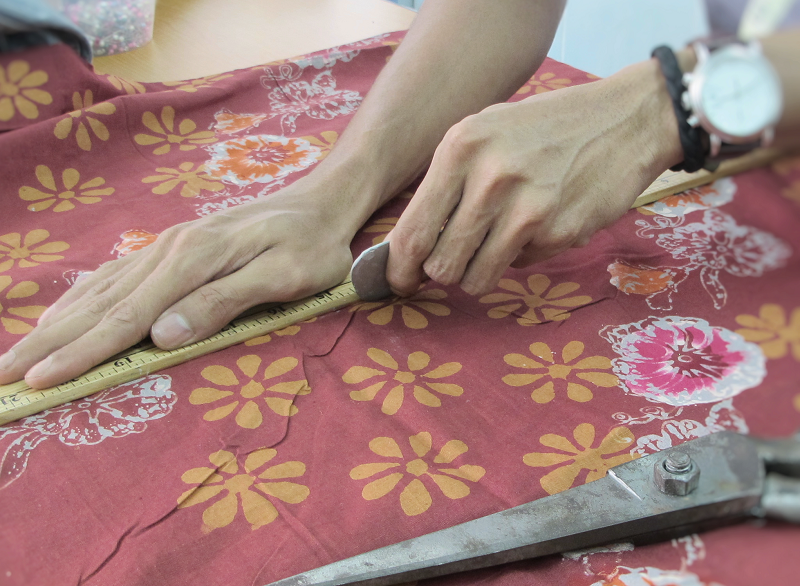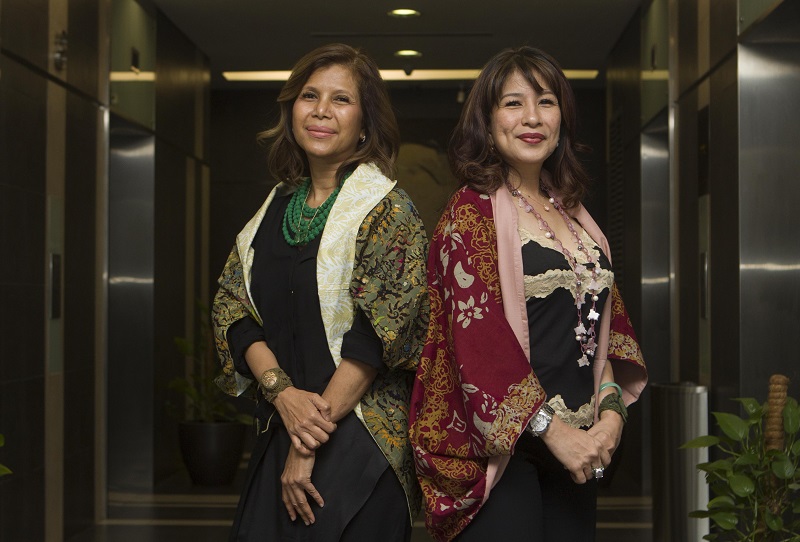
Fern Chua of Fern Batik (Photo: Suhaimi Yusuf/The Edge)
With no silver lining in sight, Fern Chua decided to draw one of her own — in wax. Having been injured in a car accident in 2000 which severed a couple of tendons and injured the median nerve in her hands, leaving them paralysed for six months, intensive physiotherapy was needed to regain full command of them. As someone who was always artistically inclined, Chua took up sewing and pattern-making to exercise her hands and fell in love with the craft, taking an especial liking to batik.
A communications graduate who worked in public relations and marketing, she chased her calling only in 2014, launching Fern Batik as a pop-up store at Bangsar Village II in Kuala Lumpur. This was after she had successful collaborations with premium batik label Ruzz Gahara and won the first edition of Fashion Pitch in 2013.
Natural fabrics such as linen, cotton and silk act as luxurious canvases for motifs ranging from marble swirls to floral silhouettes. “There’s so much Malaysian heritage in batik but people tend to have a very rigid, traditional view of its use,” she says. “It doesn’t only have to be seen as formal wear. I believe batik could be a fashionable, day-to-day lifestyle product, so I try to be more experimental with patterns and techniques.”

Snowfall is an iconic design of hers, inspired by her first experience of snow in Japan one New Year’s Eve. The whimsical design was the result of wax splashed onto the fabric with a brush before the entire cloth was painted. In fact, travel is behind much of Chua’s inspiration. The golden lustre of bamboo motifs hand-painted onto a swish dress immortalised a trip to the Arashiyama Bamboo Forest in Kyoto, Japan, while her Waves collection followed a holiday to the famed beaches of Rio de Janeiro.
Meanwhile, a menswear line includes a short-sleeved shirt with an exquisite marbled design, a coveted addition to any smart-casual wardrobe.
“We used a special marbling technique to achieve this,” says the designer. “We covered the entire fabric in wax and then manually cracked the hardened wax, which allowed the dye to seep through and create the swirled patterns. The idea of batik is to use wax to create resistance on the fabric for the dye to manoeuvre around. I like experimenting with different methods and ideas while still staying as true as I can to the craft. Many batik purveyors these days no longer use the traditional methods of wax and hand-painting, preferring instead to print patterns onto fabric as it’s cheaper and quicker to produce. A full canting piece — using a canting pen filled with wax to draw patterns by hand across the entire fabric — can be very expensive, so I play with sponges or bottle brushes to create patterns. There’s a fine line between retaining the tenets of batik and developing a modern, affordable approach.”
Prices range from RM200 for a scarf to RM1,500 for a full-length dress. Fern Batik’s pieces are available at her store in Bangsar Village II, as well as KitaKita in Bukit Damansara, Kuala Lumpur, Robinsons Kuala Lumpur at Four Seasons Place, The St Regis Langkawi in Kedah and Tanjong Jara Resort in Terengganu.
When Salihin Rashid went to Indonesia for his cousin’s wedding, he was surprised by how proudly young people there wore their batik. It made him wonder why Malaysians did not do the same. Upon returning home, he took a closer look at the traditional shirts available for men. “I found that they were baggy and old school. They were also made from materials like chiffon and satin, which are not suitable for everyday wear,” he says.

At his hometown in Kuala Terengganu, Salihin consulted his mother, who used to make batik prints when she was younger. “I told my mum about this idea I had to make modern batik shirts but she was sceptical about it because I had an actual job with a steady income,” he explains. At the time, he had just quit his job as a geologist at a consultancy firm and was waiting to begin a new position in a few weeks. He decided to give the business a go and so The Sarong Malaysia was born.
Salihin did some market research, spoke to a few friends and then began to work on a design that suited the modern man. “I collaborate with batik makers to design our own motifs and patterns. I realised early on that handmade batik in Terengganu is a dying art. There used to be more than 20 active batik makers but now, there are only eight still making batik terap (hand-blocked batik).”
The Sarong Malaysia launched its first collection last November with 50 shirts in six designs. They were sold out in a week. It was then that Salihin decided to turn down his pending job offer and focus solely on the venture. Now employing five tailors and two master cutters in Kuala Lumpur, the company makes 30 shirts a day and can produce up to 600 a month.
It was important for Salihin to have the word “Malaysia” in the brand name to emphasise that 100% of his shirts, from the material to the tailoring, is made or done in the country.
The Sarong Malaysia’s designs are stylish and perfect for the modern man. “My shirts have hidden button plackets, welt breast pockets, three-finger button-down collars and cotton inner linings. They are cool,” he points out. Customers have given glowing feedback on his shirts, which they say can be worn for any occasion — from the office to the mamak. “You can wear it anywhere and every day,” he adds.

Salihin is involved in the entire process, from creating the batik designs to sewing and selling the products at pop-up stalls. Initially, he was not used to how the batik makers work. “They are artisans and they have their own way of working. I come from a corporate background, so I like everything managed well and organised,” he says. It took a few months but they now have a comfortable rhythm that suits all parties.
“In Malaysia, we have two block makers — Zakaria Ismail in Terengganu and Md Ghani Mat in Kelantan. There are younger ones but they are still learning their craft and focused on modern and abstract designs,” Salihin explains. He remains an advocate of handmade Malaysian batik, hoping to encourage the younger generations to appreciate this beautiful art form and wear it proudly. “Handmade batik has its own character. Our generation must preserve and embrace it. It is our brand’s vision to keep our Malaysian handmade batik heritage relevant and up to date.”
Farah Wagimin and Zee @ Zauyah met on a hiking trip and clicked instantly. Their friendship continued to blossom through a series of road trips and shopping sprees, and they found that they had similar tastes. “We come up with all our best ideas when we’re in the car sitting in a jam,” says Farah.
Saarat began as a business selling macrame bracelets with semiprecious stones but in September last year, they came up with a brilliant idea — batik stoles. The friends love batik and it seemed only natural to include that love in their business.

Farah and Zee started out with 19 pieces, which they sold at bazaars, sharing a booth with other vendors. Their stoles sold out quickly and the creators decided to adapt their design according to the feedback they received. “We began to make our stoles longer to fit different body sizes,” says Farah. After trying out different tailors, the partners found two places that met their high standards. “It’s really important that the workmanship of the reversible stole is really good. Otherwise, you would be able to see that the edges are not perfect,” she adds.
“For Malaysians, when it comes to batik, they usually only think of sarongs, so we wanted to make something different,” says Zee. The idea for their batik stoles came from the hobbies they share. “We both like to hike and we like the outdoors, running in the park and all that. So, at first, we wanted something breathable that you could wear after your workouts,” explains Farah. The Saarat stole began as a two-way batik wrap that complemented one’s gym wear, but they now produce pieces for casual and semi-formal occasions as well. The stoles can be worn in four different ways, allowing customers to experiment and have fun with the style.
Sourcing the material proved to be one of their biggest hurdles. “Getting a steady supply of batik terap is the most challenging part because during rainy days and the monsoon season, the suppliers cannot make it,” says Zee. The two ladies began to realise that the batik terap they are so fond of is a dying art as there are fewer artisans who know how to make it. “It is a tedious process. The batik makers are competing with machine print, which is much cheaper, so it’s difficult to sustain,” adds Zee.
Farah and Zee decided to use their Saarat stoles to promote Malaysian batik in a modern and fashionable way, in an effort to sustain the batik terap industry. They buy it in bulk from artisans in Kelantan and Terengganu, then return to Kuala Lumpur to match the pieces before heading to the tailors. Each stole is unique — “You will never find two of the same design because batik is like that. One will have the badan and one will have the kepala,” says Zee.
“If people start to see them as casual wear, they will understand that batik is the sort of fabric that they can use every day and not just on special occasions,” Farah adds.
This article first appeared on Aug 27, 2018 in The Edge Malaysia.


